Molecule Information
General Information of the Molecule (ID: Mol00194)
| Name |
E3 ubiquitin-protein ligase XIAP (XIAP)
,Homo sapiens
|
||||
|---|---|---|---|---|---|
| Synonyms |
Baculoviral IAP repeat-containing protein 4; IAP-like protein; ILP; hILP; Inhibitor of apoptosis protein 3; IAP-3; hIAP-3; hIAP3; RING-type E3 ubiquitin transferase XIAP; X-linked inhibitor of apoptosis protein; X-linked IAP; API3; BIRC4; IAP3
Click to Show/Hide
|
||||
| Molecule Type |
Protein
|
||||
| Gene Name |
XIAP
|
||||
| Gene ID | |||||
| Location |
chrX:123859724-123913976[+]
|
||||
| Sequence |
MTFNSFEGSKTCVPADINKEEEFVEEFNRLKTFANFPSGSPVSASTLARAGFLYTGEGDT
VRCFSCHAAVDRWQYGDSAVGRHRKVSPNCRFINGFYLENSATQSTNSGIQNGQYKVENY LGSRDHFALDRPSETHADYLLRTGQVVDISDTIYPRNPAMYSEEARLKSFQNWPDYAHLT PRELASAGLYYTGIGDQVQCFCCGGKLKNWEPCDRAWSEHRRHFPNCFFVLGRNLNIRSE SDAVSSDRNFPNSTNLPRNPSMADYEARIFTFGTWIYSVNKEQLARAGFYALGEGDKVKC FHCGGGLTDWKPSEDPWEQHAKWYPGCKYLLEQKGQEYINNIHLTHSLEECLVRTTEKTP SLTRRIDDTIFQNPMVQEAIRMGFSFKDIKKIMEEKIQISGSNYKSLEVLVADLVNAQKD SMQDESSQTSLQKEISTEEQLRRLQEEKLCKICMDRNIAIVFVPCGHLVTCKQCAEAVDK CPMCYTVITFKQKIFMS Click to Show/Hide
|
||||
| Function |
Multi-functional protein which regulates not only caspases and apoptosis, but also modulates inflammatory signaling and immunity, copper homeostasis, mitogenic kinase signaling, cell proliferation, as well as cell invasion and metastasis. Acts as a direct caspase inhibitor. Directly bind to the active site pocket of CASP3 and CASP7 and obstructs substrate entry. Inactivates CASP9 by keeping it in a monomeric, inactive state. Acts as an E3 ubiquitin-protein ligase regulating NF-kappa-B signaling and the target proteins for its E3 ubiquitin-protein ligase activity include: RIPK1, CASP3, CASP7, CASP8, CASP9, MAP3K2/MEKK2, DIABLO/SMAC, AIFM1, CCS and BIRC5/survivin. Ubiquitinion of CCS leads to enhancement of its chaperone activity toward its physiologic target, SOD1, rather than proteasomal degradation. Ubiquitinion of MAP3K2/MEKK2 and AIFM1 does not lead to proteasomal degradation. Plays a role in copper homeostasis by ubiquitinating COMMD1 and promoting its proteasomal degradation. Can also function as E3 ubiquitin-protein ligase of the NEDD8 conjugation pathway, targeting effector caspases for neddylation and inactivation. Ubiquitinates and therefore mediates the proteosomal degradation of BCL2 in response to apoptosis. Regulates the BMP signaling pathway and the SMAD and MAP3K7/TAK1 dependent pathways leading to NF-kappa-B and JNK activation. Acts as an important regulator of innate immune signaling via regulation of Nodlike receptors (NLRs). Protects cells from spontaneous formation of the ripoptosome, a large multi-protein complex that has the capability to kill cancer cells in a caspase-dependent and caspase-independent manner. Suppresses ripoptosome formation by ubiquitinating RIPK1 and CASP8. Acts as a positive regulator of Wnt signaling and ubiquitinates TLE1, TLE2, TLE3, TLE4 and AES. Ubiquitination of TLE3 results in inhibition of its interaction with TCF7L2/TCF4 thereby allowing efficient recruitment and binding of the transcriptional coactivator beta-catenin to TCF7L2/TCF4 that is required to initiate a Wnt-specific transcriptional program.
Click to Show/Hide
|
||||
| Uniprot ID | |||||
| Ensembl ID | |||||
| HGNC ID | |||||
| Click to Show/Hide the Complete Species Lineage | |||||
Type(s) of Resistant Mechanism of This Molecule
Drug Resistance Data Categorized by Drug
Approved Drug(s)
9 drug(s) in total
| Drug Resistance Data Categorized by Their Corresponding Mechanisms | ||||
|
|
||||
| Disease Class: Pituitary adenoma | [1] | |||
| Resistant Disease | Pituitary adenoma [ICD-11: 2F37.1] | |||
| Resistant Drug | Carboplatin | |||
| Molecule Alteration | Expression | Up-regulation |
||
| Experimental Note | Identified from the Human Clinical Data | |||
| In Vitro Model | Pituitary tumour stem-like cells | Pituitary | Homo sapiens (Human) | N.A. |
| In Vivo Model | NOD/SCID mice xenograft model | Mus musculus | ||
| Experiment for Molecule Alteration |
qRT-PCR | |||
| Experiment for Drug Resistance |
WST-1 proliferation assay | |||
| Mechanism Description | Stem cells are generally known to preferentially express antiapoptotic genes, such as BCL-2, cIAP1, NAIP, and XIAP.The expression levels of these antiapoptotic genes in PASC1 were one- to sixfolds higher than those in its daughter cells. | |||
| Drug Resistance Data Categorized by Their Corresponding Mechanisms | ||||
|
|
||||
| Disease Class: Osteosarcoma | [2] | |||
| Resistant Disease | Osteosarcoma [ICD-11: 2B51.0] | |||
| Resistant Drug | Cisplatin | |||
| Molecule Alteration | Expression | Up-regulation |
||
| Experimental Note | Identified from the Human Clinical Data | |||
| Cell Pathway Regulation | Cell apoptosis | Activation | hsa04210 | |
| Cell viability | Inhibition | hsa05200 | ||
| In Vitro Model | MG63 cells | Bone marrow | Homo sapiens (Human) | CVCL_0426 |
| SAOS-2 cells | Bone marrow | Homo sapiens (Human) | CVCL_0548 | |
| MG63/CDDP cells | Bone | Homo sapiens (Human) | CVCL_0426 | |
| SAOS-2/CDDP cells | Bone | Homo sapiens (Human) | CVCL_0548 | |
| Experiment for Molecule Alteration |
Western blot analysis | |||
| Experiment for Drug Resistance |
CCK8 assay; Flow cytometry assay | |||
| Mechanism Description | XIAP overexpression greatly cancelled the apoptosis promoting the effect of miR377 in Saos-2/CDDP cell. | |||
| Disease Class: Gastric adenocarcinoma | [3] | |||
| Resistant Disease | Gastric adenocarcinoma [ICD-11: 2B72.0] | |||
| Resistant Drug | Cisplatin | |||
| Molecule Alteration | Expression | Up-regulation |
||
| Experimental Note | Revealed Based on the Cell Line Data | |||
| Cell Pathway Regulation | Cell apoptosis | Inhibition | hsa04210 | |
| Fas/FasL signaling pathway | Regulation | hsa04210 | ||
| In Vitro Model | SGC7901 cells | Gastric | Homo sapiens (Human) | CVCL_0520 |
| SGC7901/VCR cells | Gastric | Homo sapiens (Human) | CVCL_VU58 | |
| Experiment for Molecule Alteration |
Western blotting analysis | |||
| Experiment for Drug Resistance |
MTT assay | |||
| Mechanism Description | The anti-apoptotic protein BCL2 and XIAP were upregulated, while the miR-200bc/429 cluster was downregulated in both SGC7901/VCR and A549/CDDP cells. miR-200bc/429 cluster might play an important role in the development of MDR in human gastric and lung cancer cell lines by targeting the anti-apoptotic genes BCL2 and XIAP. | |||
| Disease Class: Lung cancer | [3] | |||
| Resistant Disease | Lung cancer [ICD-11: 2C25.5] | |||
| Resistant Drug | Cisplatin | |||
| Molecule Alteration | Expression | Up-regulation |
||
| Experimental Note | Revealed Based on the Cell Line Data | |||
| Cell Pathway Regulation | Cell apoptosis | Inhibition | hsa04210 | |
| Fas/FasL signaling pathway | Regulation | hsa04210 | ||
| In Vitro Model | A549 cells | Lung | Homo sapiens (Human) | CVCL_0023 |
| A549/CDDP cells | Lung | Homo sapiens (Human) | CVCL_0023 | |
| Experiment for Molecule Alteration |
Western blotting analysis | |||
| Experiment for Drug Resistance |
MTT assay | |||
| Mechanism Description | The anti-apoptotic protein BCL2 and XIAP were upregulated, while the miR-200bc/429 cluster was downregulated in both SGC7901/VCR and A549/CDDP cells. miR-200bc/429 cluster might play an important role in the development of MDR in human gastric and lung cancer cell lines by targeting the anti-apoptotic genes BCL2 and XIAP. | |||
| Disease Class: Ovarian cancer | [4] | |||
| Resistant Disease | Ovarian cancer [ICD-11: 2C73.0] | |||
| Resistant Drug | Cisplatin | |||
| Molecule Alteration | Expression | Up-regulation |
||
| Experimental Note | Identified from the Human Clinical Data | |||
| Cell Pathway Regulation | Cell apoptosis | Activation | hsa04210 | |
| Cell autophagy | Inhibition | hsa04140 | ||
| In Vitro Model | CAOV3 cells | Ovary | Homo sapiens (Human) | CVCL_0201 |
| OVCA433 cells | Ovary | Homo sapiens (Human) | CVCL_0475 | |
| ALST cells | Ovary | Homo sapiens (Human) | CVCL_W778 | |
| OVCA432 cells | Ovary | Homo sapiens (Human) | CVCL_3769 | |
| OVCA 420 cells | Breast | Homo sapiens (Human) | CVCL_3935 | |
| OVCA3 cells | Ovary | Homo sapiens (Human) | CVCL_0465 | |
| OVCA429 cells | Ovary | Homo sapiens (Human) | CVCL_3936 | |
| OVCA633 cells | Ovary | Homo sapiens (Human) | CVCL_W776 | |
| OVCA680 cells | Ovary | Homo sapiens (Human) | CVCL_W781 | |
| OVCA702 cells | Ovary | Homo sapiens (Human) | CVCL_W782 | |
| OVCA810 cells | Ovary | Homo sapiens (Human) | CVCL_W783 | |
| Experiment for Molecule Alteration |
Combined immunostaining and chromosome painting assay | |||
| Experiment for Drug Resistance |
MTT assay | |||
| Mechanism Description | One possible down-stream candidate is XIAP, which is the most potent direct inhibitor of caspases and apoptosis among all human IAP family proteins. Down-regulated expression of XIAP has been shown to induce apoptosis in chemoresistant human ovarian cancer cells. Down-regulation of XIST might increase the expression level of XIAP and block drug-induced apoptosis to cause resistance phenotype. | |||
| Drug Sensitivity Data Categorized by Their Corresponding Mechanisms | ||||
|
|
||||
| Disease Class: Ovarian cancer | [5] | |||
| Sensitive Disease | Ovarian cancer [ICD-11: 2C73.0] | |||
| Sensitive Drug | Cisplatin | |||
| Molecule Alteration | Expression | Down-regulation |
||
| Experimental Note | Revealed Based on the Cell Line Data | |||
| Cell Pathway Regulation | Cell apoptosis | Inhibition | hsa04210 | |
| In Vitro Model | SkOV3 cells | Ovary | Homo sapiens (Human) | CVCL_0532 |
| OVCAR3 cells | Ovary | Homo sapiens (Human) | CVCL_0465 | |
| Experiment for Molecule Alteration |
Dual luciferase reporter assay; Western blot analysis | |||
| Experiment for Drug Resistance |
MTT assay | |||
| Mechanism Description | microRNA 146a 5p enhances cisplatin induced apoptosis in ovarian cancer cells by targeting multiple anti apoptotic genes, including XIAP, BCL2L2 and BIRC5 via their 3'UTRs. | |||
| Disease Class: Ovarian cancer | [6] | |||
| Sensitive Disease | Ovarian cancer [ICD-11: 2C73.0] | |||
| Sensitive Drug | Cisplatin | |||
| Molecule Alteration | Expression | Down-regulation |
||
| Experimental Note | Revealed Based on the Cell Line Data | |||
| Cell Pathway Regulation | Cell apoptosis | Activation | hsa04210 | |
| Cell viability | Inhibition | hsa05200 | ||
| In Vitro Model | SkOV3 cells | Ovary | Homo sapiens (Human) | CVCL_0532 |
| HEK293T cells | Kidney | Homo sapiens (Human) | CVCL_0063 | |
| OVCAR3 cells | Ovary | Homo sapiens (Human) | CVCL_0465 | |
| Experiment for Molecule Alteration |
Western blot analysis | |||
| Experiment for Drug Resistance |
MTT assay; Flow cytometry assay | |||
| Mechanism Description | miR-142-5p decreases cisplatin IC50 in OVCAR3 and SkOV3 ovarian cancer cells via downregulating XIAP. | |||
| Disease Class: Epithelial ovarian cancer | [7] | |||
| Sensitive Disease | Epithelial ovarian cancer [ICD-11: 2B5D.0] | |||
| Sensitive Drug | Cisplatin | |||
| Molecule Alteration | Expression | Down-regulation |
||
| Experimental Note | Revealed Based on the Cell Line Data | |||
| Cell Pathway Regulation | Cell apoptosis | Activation | hsa04210 | |
| Cell proliferation | Inhibition | hsa05200 | ||
| In Vitro Model | SkOV3 cells | Ovary | Homo sapiens (Human) | CVCL_0532 |
| A2780 cells | Ovary | Homo sapiens (Human) | CVCL_0134 | |
| Experiment for Molecule Alteration |
Western blot analysis | |||
| Experiment for Drug Resistance |
MTT assay | |||
| Mechanism Description | Overexpression of miR-509-3p can not only downregulate the expression of XIAP in ovarian cancer cells but also inhibit the proliferation of EOC cells and increase their sensitivity to cisplatin-induced apoptosis. | |||
| Drug Resistance Data Categorized by Their Corresponding Mechanisms | ||||
|
|
||||
| Disease Class: Acute myeloid leukemia | [8] | |||
| Resistant Disease | Acute myeloid leukemia [ICD-11: 2A60.0] | |||
| Resistant Drug | Doxorubicin | |||
| Molecule Alteration | Expression | Up-regulation |
||
| Experimental Note | Identified from the Human Clinical Data | |||
| Cell Pathway Regulation | Cell apoptosis | Activation | hsa04210 | |
| In Vitro Model | THP-1 cells | Blood | Homo sapiens (Human) | CVCL_0006 |
| Experiment for Molecule Alteration |
Western blot analysis; RT-qPCR | |||
| Experiment for Drug Resistance |
Flow cytometry assay | |||
| Mechanism Description | CircPAN3 mediates drug resistance in acute myeloid leukemia through the miR-153-5p/miR-183-5p-XIAP axis. | |||
| Drug Resistance Data Categorized by Their Corresponding Mechanisms | ||||
|
|
||||
| Disease Class: Pituitary adenoma | [1] | |||
| Resistant Disease | Pituitary adenoma [ICD-11: 2F37.1] | |||
| Resistant Drug | Etoposide | |||
| Molecule Alteration | Expression | Up-regulation |
||
| Experimental Note | Identified from the Human Clinical Data | |||
| In Vitro Model | Pituitary tumour stem-like cells | Pituitary | Homo sapiens (Human) | N.A. |
| In Vivo Model | NOD/SCID mice xenograft model | Mus musculus | ||
| Experiment for Molecule Alteration |
qRT-PCR | |||
| Experiment for Drug Resistance |
WST-1 proliferation assay | |||
| Mechanism Description | Stem cells are generally known to preferentially express antiapoptotic genes, such as BCL-2, cIAP1, NAIP, and XIAP.The expression levels of these antiapoptotic genes in PASC1 were one- to sixfolds higher than those in its daughter cells. | |||
| Drug Sensitivity Data Categorized by Their Corresponding Mechanisms | ||||
|
|
||||
| Disease Class: Chronic lymphocytic leukemia | [9] | |||
| Sensitive Disease | Chronic lymphocytic leukemia [ICD-11: 2A82.0] | |||
| Sensitive Drug | Fludarabine | |||
| Molecule Alteration | Expression | Down-regulation |
||
| Experimental Note | Identified from the Human Clinical Data | |||
| Cell Pathway Regulation | Cell apoptosis | Activation | hsa04210 | |
| In Vitro Model | CLL B cells | Lymph | Homo sapiens (Human) | N.A. |
| Experiment for Molecule Alteration |
Western blotting analysis | |||
| Experiment for Drug Resistance |
Flow cytometry assay | |||
| Mechanism Description | miR-181a and miR-181b directly inhibit the expression of BCL-2, MCL-1 and XIAP by binding to the target sequence, sensitizes CLL cells to fludarabine-induced apoptosis. | |||
| Drug Sensitivity Data Categorized by Their Corresponding Mechanisms | ||||
|
|
||||
| Disease Class: Colon cancer | [10] | |||
| Sensitive Disease | Colon cancer [ICD-11: 2B90.1] | |||
| Sensitive Drug | Fluorouracil | |||
| Molecule Alteration | Expression | Up-regulation |
||
| Experimental Note | Revealed Based on the Cell Line Data | |||
| Cell Pathway Regulation | Cell migration | Inhibition | hsa04670 | |
| In Vitro Model | DLD1 cells | Colon | Homo sapiens (Human) | CVCL_0248 |
| SW620 cells | Colon | Homo sapiens (Human) | CVCL_0547 | |
| HCT116 cells | Colon | Homo sapiens (Human) | CVCL_0291 | |
| NCM460 cells | Colon | Homo sapiens (Human) | CVCL_0460 | |
| SW1116 cells | Colon | Homo sapiens (Human) | CVCL_0544 | |
| In Vivo Model | Nude mouse xenograft model | Mus musculus | ||
| Experiment for Molecule Alteration |
qRT-PCR | |||
| Experiment for Drug Resistance |
CellTiter-Glo Luminescent Cell Viability Assay; CCK8 assay; Flow cytometric analysis | |||
| Mechanism Description | Overexpression of XIAP decreases the inhibitory effects of miR15b-5p on drug resistance in colon cancer cells. miR15b-5p mediates NF- B regulation by targeting the anti-apoptosis protein XIAP in vitro. | |||
|
|
||||
| Disease Class: Colorectal cancer | [11] | |||
| Sensitive Disease | Colorectal cancer [ICD-11: 2B91.1] | |||
| Sensitive Drug | Fluorouracil | |||
| Molecule Alteration | Expression | Down-regulation |
||
| Experimental Note | Identified from the Human Clinical Data | |||
| Cell Pathway Regulation | Cell apoptosis | Activation | hsa04210 | |
| Cell proliferation | Inhibition | hsa05200 | ||
| In Vitro Model | SW480 cells | Colon | Homo sapiens (Human) | CVCL_0546 |
| LOVO cells | Colon | Homo sapiens (Human) | CVCL_0399 | |
| NCM460 cells | Colon | Homo sapiens (Human) | CVCL_0460 | |
| SW1116 cells | Colon | Homo sapiens (Human) | CVCL_0544 | |
| HCT-116 cells | Colon | Homo sapiens (Human) | N.A. | |
| Experiment for Molecule Alteration |
RT-qPCR; Western blot analysiss | |||
| Experiment for Drug Resistance |
MTT assay | |||
| Mechanism Description | miR-874 inhibits growth, increases apoptosis and enhances chemosensitivity in CRC cells by targeting XIAP. | |||
| Drug Sensitivity Data Categorized by Their Corresponding Mechanisms | ||||
|
|
||||
| Disease Class: Chronic myeloid leukemia | [12] | |||
| Sensitive Disease | Chronic myeloid leukemia [ICD-11: 2A20.0] | |||
| Sensitive Drug | Imatinib | |||
| Molecule Alteration | Expression | Up-regulation |
||
| Experimental Note | Revealed Based on the Cell Line Data | |||
| Cell Pathway Regulation | Cell apoptosis | Activation | hsa04210 | |
| p53 signaling pathway | Regulation | hsa04115 | ||
| In Vitro Model | K562 cells | Blood | Homo sapiens (Human) | CVCL_0004 |
| Experiment for Molecule Alteration |
Western blot analysis | |||
| Experiment for Drug Resistance |
Flow cytometry assay | |||
| Mechanism Description | BCL-2, MCL-1 and XIAP were the target genes of miR-130a. BCL-2, MCL-1, TCL-1 and XIAP protein levels were significantly higher in patients with drug-sensitive CML cells. Transfected miR-130a mimics significantly decreased the protein expression of BCL-1, MCL-1 and XIAP. Transfected miR-130a significantly increased the CML sensitivity to Gleevec. | |||
| Drug Sensitivity Data Categorized by Their Corresponding Mechanisms | ||||
|
|
||||
| Disease Class: Colorectal cancer | [13] | |||
| Sensitive Disease | Colorectal cancer [ICD-11: 2B91.1] | |||
| Sensitive Drug | Oxaliplatin | |||
| Molecule Alteration | Expression | Down-regulation |
||
| Experimental Note | Revealed Based on the Cell Line Data | |||
| Cell Pathway Regulation | Cell apoptosis | Activation | hsa04210 | |
| Cell viability | Inhibition | hsa05200 | ||
| In Vitro Model | HT29 Cells | Colon | Homo sapiens (Human) | CVCL_A8EZ |
| SW480 cells | Colon | Homo sapiens (Human) | CVCL_0546 | |
| In Vivo Model | BALB/c nude mouse xenograft model | Mus musculus | ||
| Experiment for Molecule Alteration |
Western blot analysis | |||
| Experiment for Drug Resistance |
CCK8 assay; Flow cytometry assay | |||
| Mechanism Description | The recovery of miR-122 expression can sensitize SW480/OR and HT29/OR cells to oxaliplatin-mediated apoptosis through the inhibition of XIAP expression. | |||
| Drug Resistance Data Categorized by Their Corresponding Mechanisms | ||||
|
|
||||
| Disease Class: Gastric adenocarcinoma | [3] | |||
| Resistant Disease | Gastric adenocarcinoma [ICD-11: 2B72.0] | |||
| Resistant Drug | Vincristine | |||
| Molecule Alteration | Expression | Up-regulation |
||
| Experimental Note | Revealed Based on the Cell Line Data | |||
| Cell Pathway Regulation | Cell apoptosis | Inhibition | hsa04210 | |
| Fas/FasL signaling pathway | Regulation | hsa04210 | ||
| In Vitro Model | SGC7901 cells | Gastric | Homo sapiens (Human) | CVCL_0520 |
| SGC7901/VCR cells | Gastric | Homo sapiens (Human) | CVCL_VU58 | |
| Experiment for Molecule Alteration |
Western blotting analysis | |||
| Experiment for Drug Resistance |
MTT assay | |||
| Mechanism Description | The anti-apoptotic protein BCL2 and XIAP were upregulated, while the miR-200bc/429 cluster was downregulated in both SGC7901/VCR and A549/CDDP cells. miR-200bc/429 cluster might play an important role in the development of MDR in human gastric and lung cancer cell lines by targeting the anti-apoptotic genes BCL2 and XIAP. | |||
| Disease Class: Lung cancer | [3] | |||
| Resistant Disease | Lung cancer [ICD-11: 2C25.5] | |||
| Resistant Drug | Vincristine | |||
| Molecule Alteration | Expression | Up-regulation |
||
| Experimental Note | Revealed Based on the Cell Line Data | |||
| Cell Pathway Regulation | Cell apoptosis | Inhibition | hsa04210 | |
| Fas/FasL signaling pathway | Regulation | hsa04210 | ||
| In Vitro Model | A549 cells | Lung | Homo sapiens (Human) | CVCL_0023 |
| A549/CDDP cells | Lung | Homo sapiens (Human) | CVCL_0023 | |
| Experiment for Molecule Alteration |
Western blotting analysis | |||
| Experiment for Drug Resistance |
MTT assay | |||
| Mechanism Description | The anti-apoptotic protein BCL2 and XIAP were upregulated, while the miR-200bc/429 cluster was downregulated in both SGC7901/VCR and A549/CDDP cells. miR-200bc/429 cluster might play an important role in the development of MDR in human gastric and lung cancer cell lines by targeting the anti-apoptotic genes BCL2 and XIAP. | |||
Disease- and Tissue-specific Abundances of This Molecule
ICD Disease Classification 02

| Differential expression of molecule in resistant diseases | ||
| The Studied Tissue | Whole blood | |
| The Specified Disease | Myelofibrosis | |
| The Expression Level of Disease Section Compare with the Healthy Individual Tissue | p-value: 8.85E-03; Fold-change: -3.14E-01; Z-score: -1.91E+00 | |
|
Molecule expression in the diseased tissue of patients
Molecule expression in the normal tissue of healthy individuals
|
||
| Disease-specific Molecule Abundances |
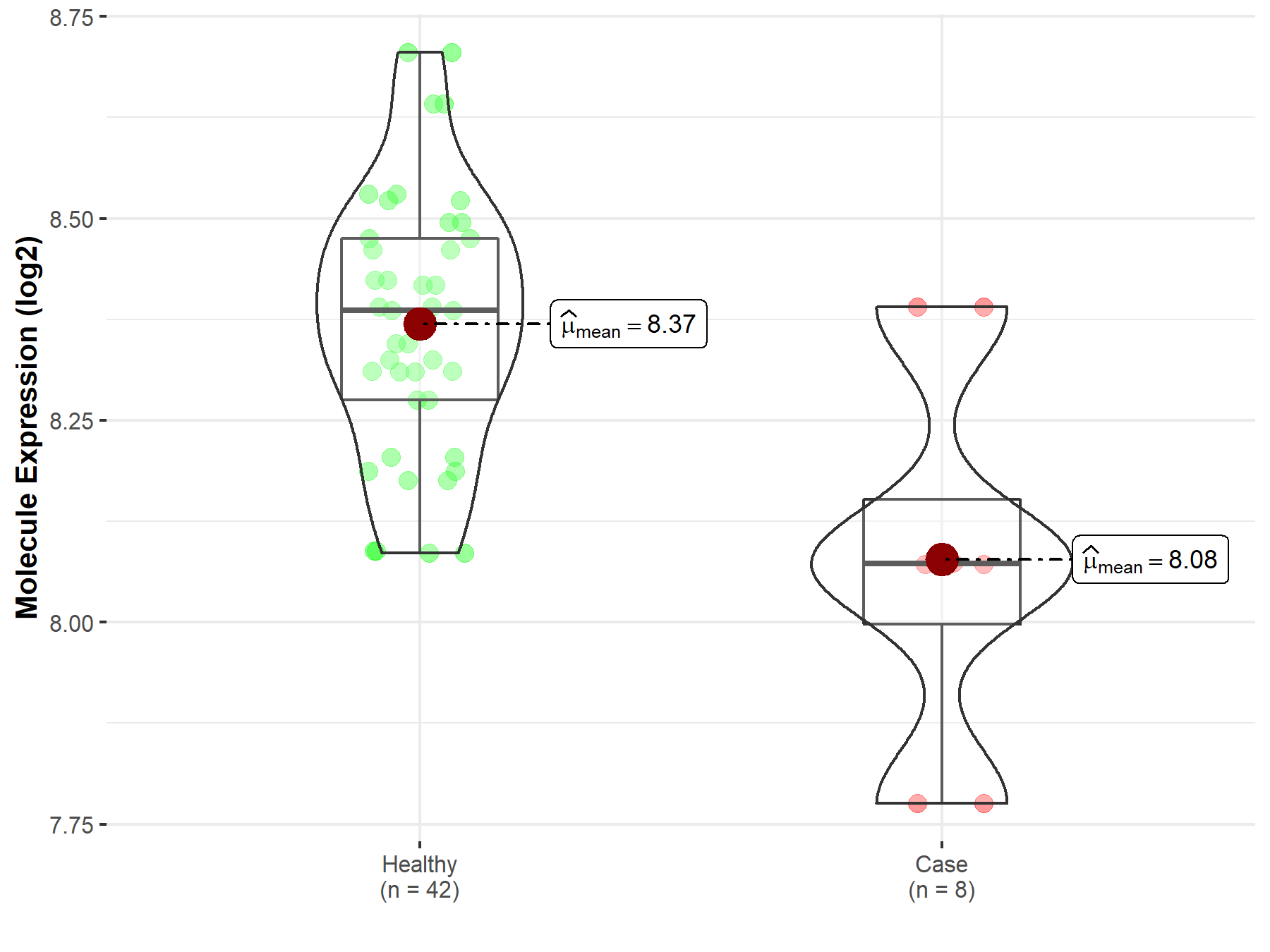
|
Click to View the Clearer Original Diagram |
| The Studied Tissue | Whole blood | |
| The Specified Disease | Polycythemia vera | |
| The Expression Level of Disease Section Compare with the Healthy Individual Tissue | p-value: 7.63E-03; Fold-change: -6.43E-02; Z-score: -3.84E-01 | |
|
Molecule expression in the diseased tissue of patients
Molecule expression in the normal tissue of healthy individuals
|
||
| Disease-specific Molecule Abundances |

|
Click to View the Clearer Original Diagram |
| Differential expression of molecule in resistant diseases | ||
| The Studied Tissue | Bone marrow | |
| The Specified Disease | Acute myeloid leukemia | |
| The Expression Level of Disease Section Compare with the Healthy Individual Tissue | p-value: 6.72E-01; Fold-change: -5.01E-02; Z-score: -1.05E-01 | |
|
Molecule expression in the diseased tissue of patients
Molecule expression in the normal tissue of healthy individuals
|
||
| Disease-specific Molecule Abundances |

|
Click to View the Clearer Original Diagram |
| Differential expression of molecule in resistant diseases | ||
| The Studied Tissue | Gastric tissue | |
| The Specified Disease | Gastric cancer | |
| The Expression Level of Disease Section Compare with the Healthy Individual Tissue | p-value: 9.39E-01; Fold-change: -3.34E-01; Z-score: -6.01E-01 | |
| The Expression Level of Disease Section Compare with the Adjacent Tissue | p-value: 3.51E-04; Fold-change: -3.57E-01; Z-score: -9.83E-01 | |
|
Molecule expression in the normal tissue adjacent to the diseased tissue of patients
Molecule expression in the diseased tissue of patients
Molecule expression in the normal tissue of healthy individuals
|
||
| Disease-specific Molecule Abundances |
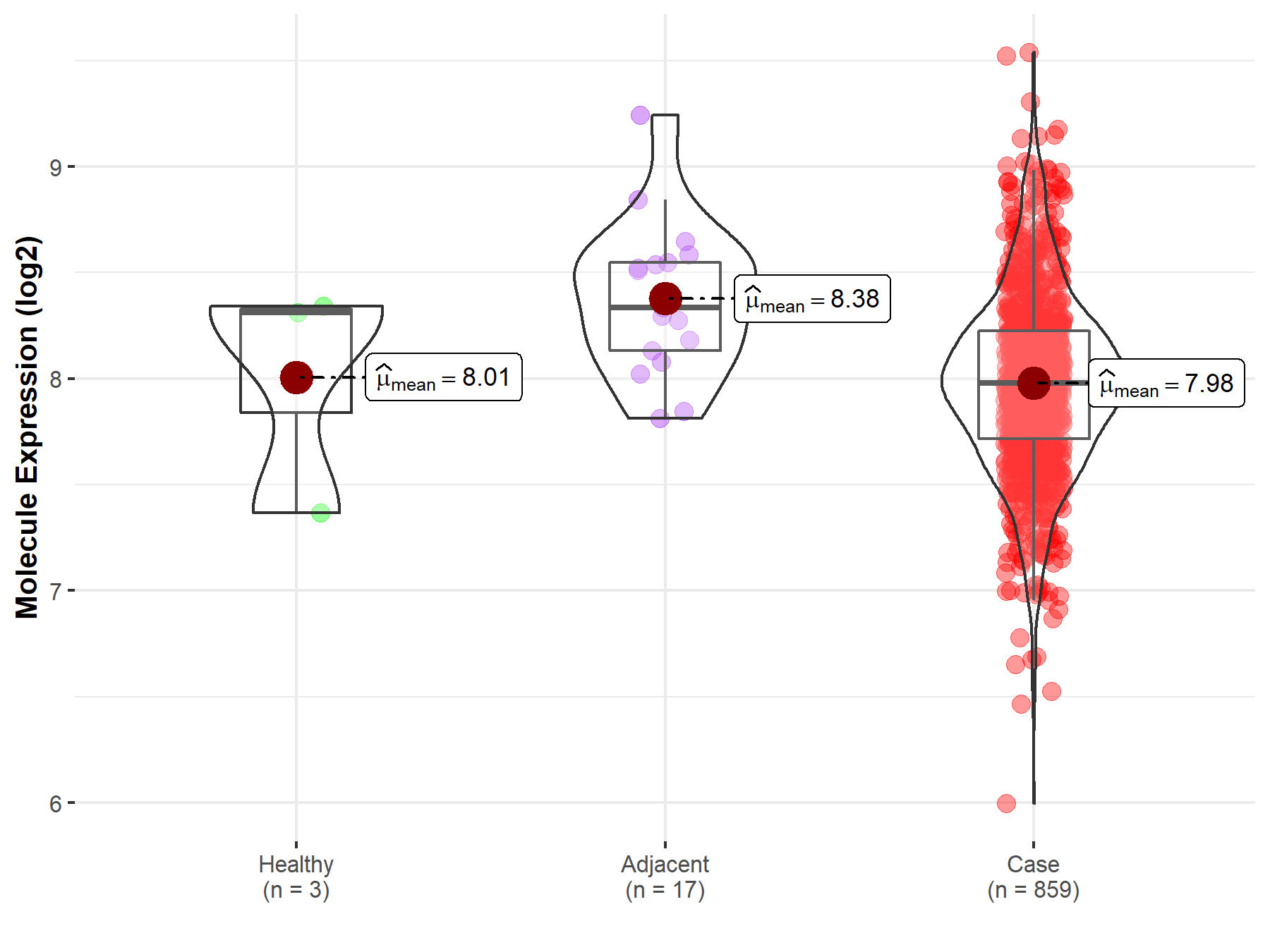
|
Click to View the Clearer Original Diagram |
| Differential expression of molecule in resistant diseases | ||
| The Studied Tissue | Colon | |
| The Specified Disease | Colon cancer | |
| The Expression Level of Disease Section Compare with the Healthy Individual Tissue | p-value: 1.83E-13; Fold-change: -2.35E-01; Z-score: -6.53E-01 | |
| The Expression Level of Disease Section Compare with the Adjacent Tissue | p-value: 9.95E-01; Fold-change: 3.31E-02; Z-score: 7.38E-02 | |
|
Molecule expression in the normal tissue adjacent to the diseased tissue of patients
Molecule expression in the diseased tissue of patients
Molecule expression in the normal tissue of healthy individuals
|
||
| Disease-specific Molecule Abundances |
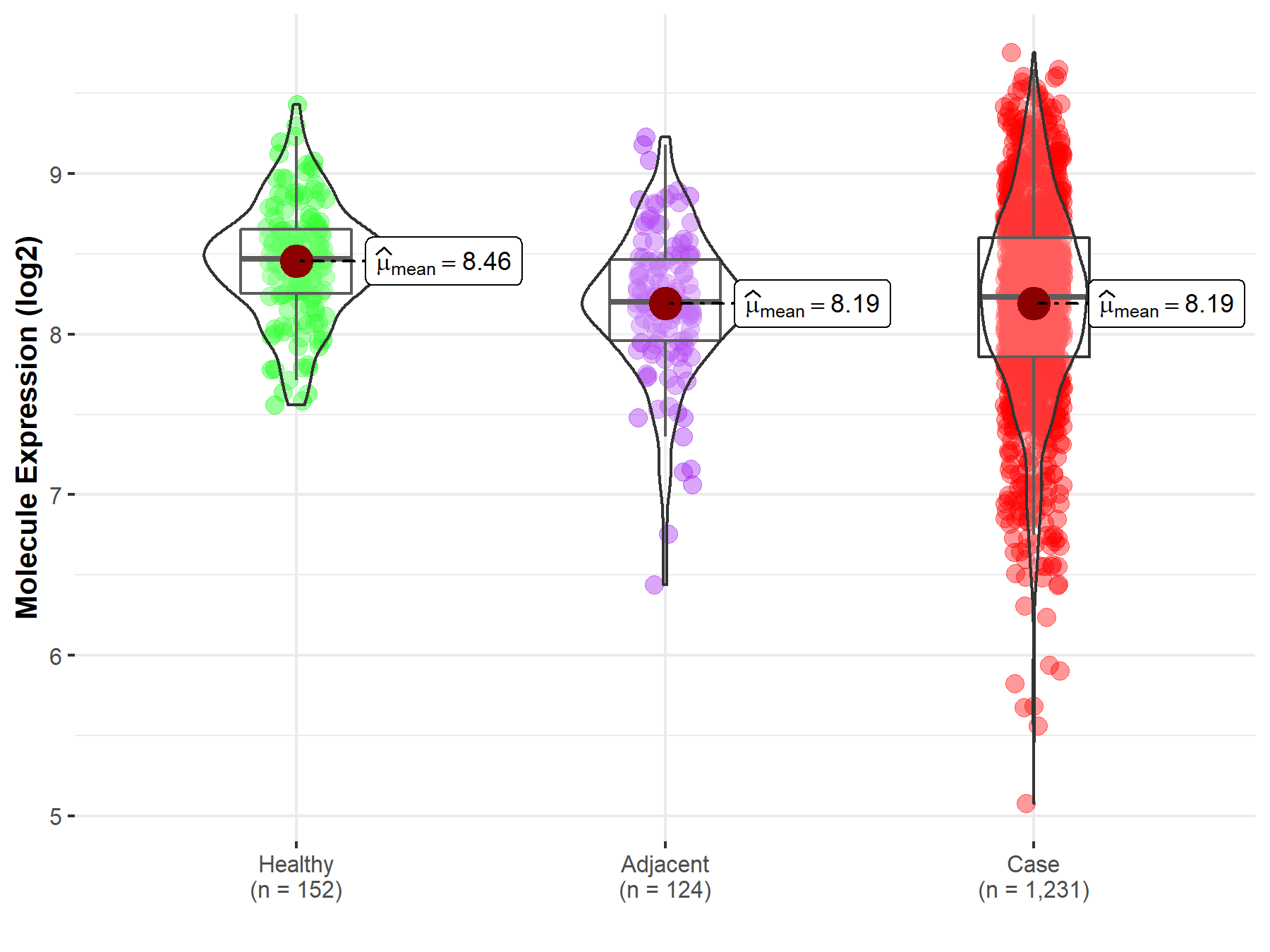
|
Click to View the Clearer Original Diagram |
| Differential expression of molecule in resistant diseases | ||
| The Studied Tissue | Lung | |
| The Specified Disease | Lung cancer | |
| The Expression Level of Disease Section Compare with the Healthy Individual Tissue | p-value: 6.62E-01; Fold-change: -6.52E-02; Z-score: -1.88E-01 | |
| The Expression Level of Disease Section Compare with the Adjacent Tissue | p-value: 6.47E-04; Fold-change: 1.09E-01; Z-score: 2.59E-01 | |
|
Molecule expression in the normal tissue adjacent to the diseased tissue of patients
Molecule expression in the diseased tissue of patients
Molecule expression in the normal tissue of healthy individuals
|
||
| Disease-specific Molecule Abundances |

|
Click to View the Clearer Original Diagram |
| Differential expression of molecule in resistant diseases | ||
| The Studied Tissue | Ovary | |
| The Specified Disease | Ovarian cancer | |
| The Expression Level of Disease Section Compare with the Healthy Individual Tissue | p-value: 1.65E-01; Fold-change: 3.32E-01; Z-score: 4.91E-01 | |
| The Expression Level of Disease Section Compare with the Adjacent Tissue | p-value: 4.85E-03; Fold-change: 1.03E+00; Z-score: 1.55E+00 | |
|
Molecule expression in the normal tissue adjacent to the diseased tissue of patients
Molecule expression in the diseased tissue of patients
Molecule expression in the normal tissue of healthy individuals
|
||
| Disease-specific Molecule Abundances |
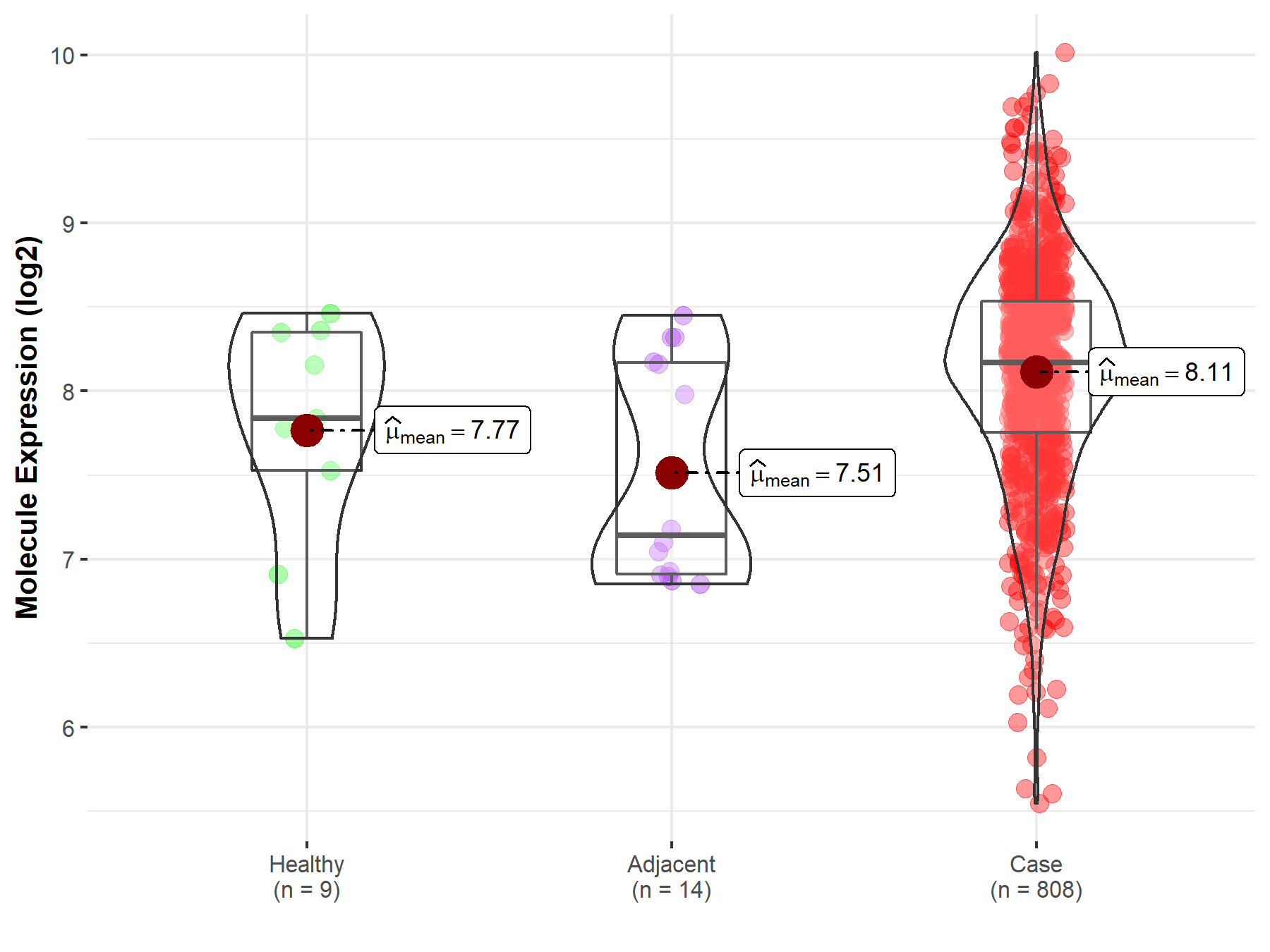
|
Click to View the Clearer Original Diagram |
| Differential expression of molecule in resistant diseases | ||
| The Studied Tissue | Pituitary | |
| The Specified Disease | Pituitary cancer | |
| The Expression Level of Disease Section Compare with the Healthy Individual Tissue | p-value: 6.65E-02; Fold-change: -2.06E-01; Z-score: -5.06E-01 | |
|
Molecule expression in the diseased tissue of patients
Molecule expression in the normal tissue of healthy individuals
|
||
| Disease-specific Molecule Abundances |

|
Click to View the Clearer Original Diagram |
| The Studied Tissue | Pituitary | |
| The Specified Disease | Pituitary gonadotrope tumor | |
| The Expression Level of Disease Section Compare with the Healthy Individual Tissue | p-value: 9.35E-02; Fold-change: -2.71E-01; Z-score: -6.16E-01 | |
|
Molecule expression in the diseased tissue of patients
Molecule expression in the normal tissue of healthy individuals
|
||
| Disease-specific Molecule Abundances |
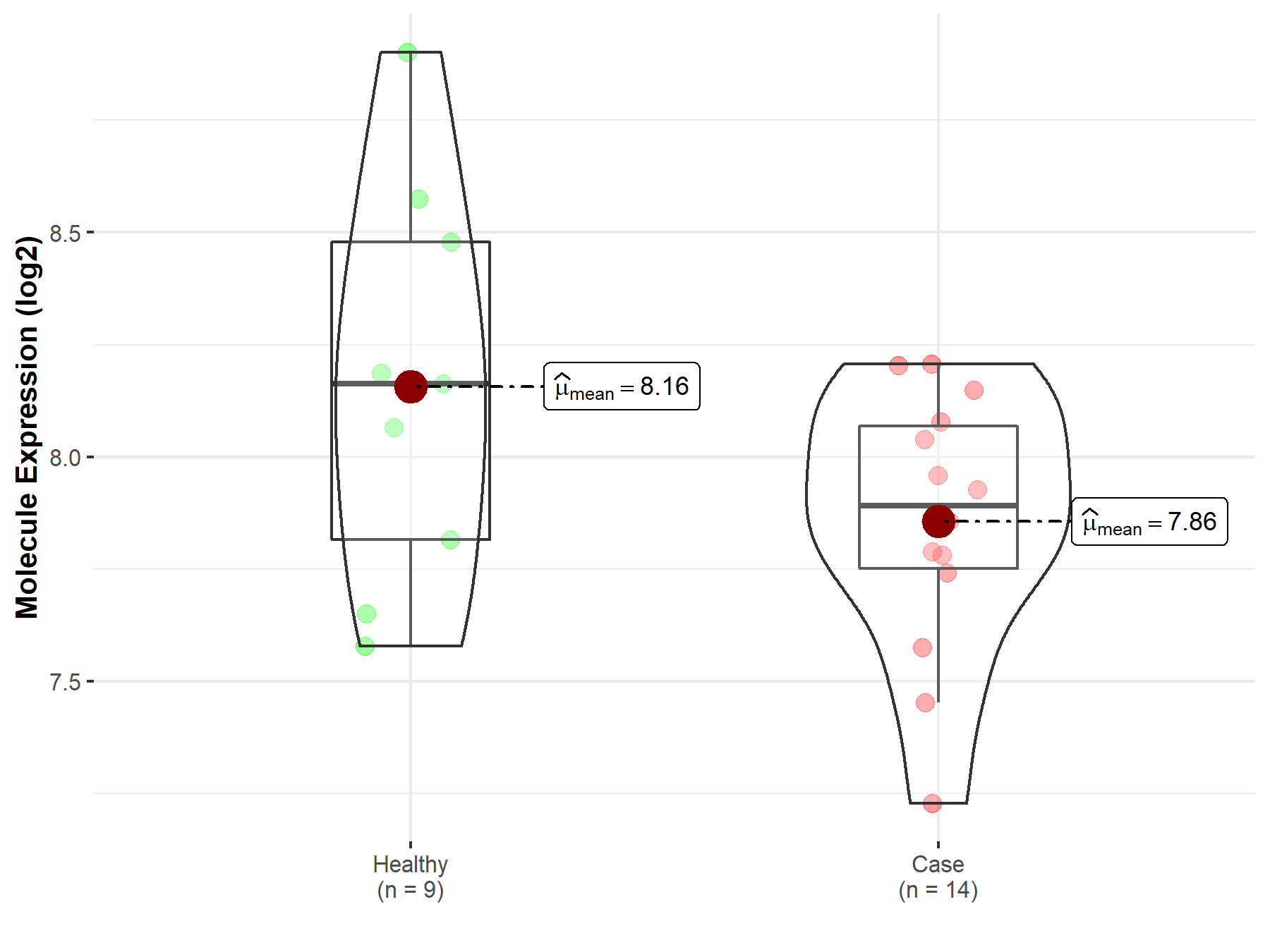
|
Click to View the Clearer Original Diagram |
Tissue-specific Molecule Abundances in Healthy Individuals

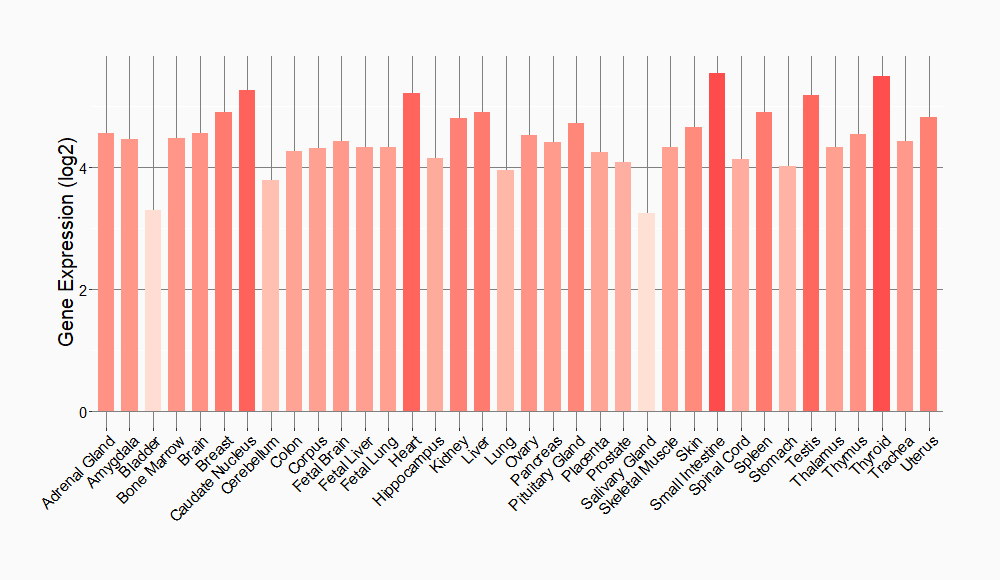
|
||
References
If you find any error in data or bug in web service, please kindly report it to Dr. Sun and Dr. Zhang.
